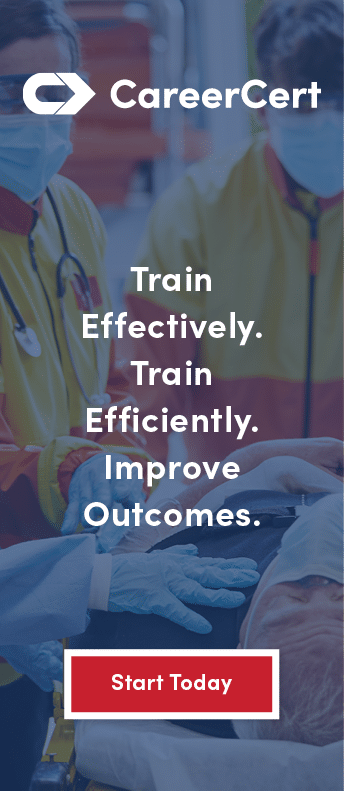How to Recognize Mental Health Distress in Your Department and Yourself
1 in 5 EMS providers experience PTSD symptoms, but researchers estimate it is more pervasive due to underreporting. A culture of toughness encourages sufferers to suppress emotions, deterring them from seeking help. Unfortunately, EMS preferred coping strategies like avoidance increases, instead of decreasing, traumatic stress symptoms. Untreated mental distress evolves into chronic behavioral health conditions that affect work performance and impair quality of life. A lack of education on signs of mental distress and the tendency for EMS to mask their true feelings makes recognition difficult. The following list of symptoms and circumstances associated with PTSD will help you recognize mental distress in your department or yourself.
1) On High Alert
Any stressful situation that activates the flight-or-fight response because of either a real or perceived threat accelerates the heart rate and elevates blood pressure. The affected person enters a hypervigilant state where they are on guard. Some remain on alert even once the threat passes and experience difficulty relaxing and sleeping. Some studies report that as high as 72% of EMS providers sleep poorly. In addition, they may easily startle, have trouble concentrating and completing simple tasks. The mental exhaustion of living in a persistent state of arousal leads to aggression, and sufferers may conflict more with supervisors. On the mild end of the spectrum, this manifests as increased irritability. In severe cases, a person may commit physical acts of violence.
2) Absent or Absent Minded
Some respond to trauma by retreating into themselves. A detached response typically manifests after a traumatic event occurs. The person becomes less responsive to stimuli and appears more subdued. They may report loss of intimacy with loved ones and disinterest in usually enjoyed activities.
3) Negative Shop Talk
Note the language EMS uses to describe patients and their work. Burnout mutates empathy into antipathy and is reflected by how they speak. Sufferers may mock patients and or justify why they deserved a poor outcome. A negative attitude is a side effect of depersonalization and is a protective measure against emotional investment in a patient’s problems and the anguish of a disappointing result. Those experiencing burnout will dismiss the value of their contributions and voice little or no personal satisfaction gained from working. Two studies confirmed that a lack of pride in the job correlated with PTSD.
4) Drowning Sorrows in Substances
Appetite changes and increased substance use indicate mental distress. Most sufferers experience a loss of appetite following a traumatic event, but any change in baseline appetite is worth noting. Binge eating can also be a form of self-soothing. Having a drink to unwind at the end of a long day is a daily ritual for many and not immediately alarming. When a person uses substances instead of recommended therapeutic interventions, they are more likely to develop an unhealthy dependence. EMS personnel are at particular risk for drug abuse. One study reported high-risk alcohol and drug use rates among emergency response professionals as high as 40%.
In addition to the signs above, PTSD relates to the following circumstances.
Overidentification: EMS are more likely to experience mental distress when a victim reminds them of a loved one or themselves. First responders who lived nearby a disaster zone reported higher levels of PTSD than those that didn’t. In another study, identification with survivors resulted in more compulsive and intrusive thoughts.
Dead Bodies: Any scene with human remains increases the risk of PTSD. Working with burned, badly damaged, natural-looking bodies or child victims is especially traumatic.
Scene Duration, Location, and Time: Those that worked in the epicenter of a disaster and were first on scene report higher mental distress than those that worked on the outskirts or arrived much later. Long hours on-site if not followed up by time off also resulted in more health complaints.
Experience Level: Experienced EMS report less mental distress depending on their career. A career characterized chiefly by successful operations protects EMS from PTSD. Confidence in personal competency and knowledge improves post-disaster wellbeing. Doing work outside of one’s usual duties increases the risk of distress following a traumatic event.
Type of Event: Man-made disasters produce more distress than natural ones.
Contributing Factors: Homelife stressors such as a recent separation or divorce worsen mental distress. Some backgrounds increase the likelihood that an EMS professional will have poor coping skills such as previous war experience, graduation from a rural high school, or prior emergency work before becoming an EMS.
COVID consideration: Team member interaction is essential for maintaining EMS morale, but social distancing recommendations to slow the spread of COVID-19 may interfere with this therapeutic outlet and intensify post-traumatic stress by increasing isolation. Encourage department vaccination to ease COVID restrictions and resume normal socialization.
If reading through these behaviors and situations reminds you of a co-worker, approach them with your concerns, or confide them in a trusted supervisor. If you recognize any of these behaviors in yourself, get help. Silence suffocates. Start by speaking to a friend, colleague, partner, or family member today. Trauma doesn’t need to cause pain every day. Relief is possible once you speak up.
Sources
- Collopy, K. T. (2012, September 10). Are You Under Stress in EMS? EMS World. https://www.emsworld.com/article/10776875/are-you-under-stress-ems.
- Donnelly, E., & Siebert, D. Occupational risk factors in the emergency medical services. Prehospital and disaster medicine. https://pubmed.ncbi.nlm.nih.gov/20066645/.
- Brooks, S. K., Dunn, R., Amlôt, R., Greenberg, N., & Rubin, G. J. (2016). Social and occupational factors associated with psychological distress and disorder among disaster responders: a systematic review. BMC psychology, 4, 18. https://doi.org/10.1186/s40359-016-0120-9
- Benedek, D., Fullerton, C.,& Ursano, Robert. First Responders: Mental Health Consequences of Natural and Human-Made Disasters for Public Health and Public Safety Workers Annual Review of Public Health 2007 28:1, 55-68




